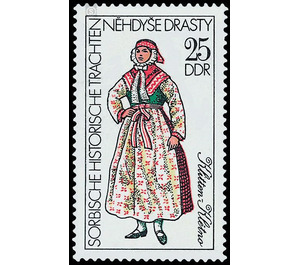Sorbian historical costumes - Germany / German Democratic Republic 1977 - 25 Pfennig
Theme: Art & Culture
| Country | Germany / German Democratic Republic |
| Issue Date | 1977 |
| Face Value | 25.00 |
| Color | multi-colored |
| Perforation | K 14 1/4 |
| Printing Type | Rotogravure 2 |
| Stamp Type | Postage stamp |
| Item Type | Stamp |
| Chronological Issue Number | 1954 |
| Chronological Chapter | GER-DDR |
| SID | 699850 |
| In 22 Wishlists | |
Sorbian Historical Costumes The Ministry of Posts and Telecommunications of the German Democratic Republic issues five multicolored special postage stamps with pictures of Sorbian historical women's costumes. Sorbian historical costumes Around the middle of the 19th century, all Sorbian girls and women of Lusatia wore folk costumes, while the men were already turning to fashionable clothing. Today, Sorbian folk costumes can only be found in four costal regions in the districts of Cottbus and Dresden, where they usually carry only older women. As early as 1968 festival costumes and 1972 dance costumes were displayed on special postage stamps from these areas. The present series is dedicated to the Sorbian-historical costumes, which, on a recent occasion in honor of the IX. Federal Congress of Domowina, the socialist national organization of the Sorbs, appears. These costumes, also known as truids, were created in the past for a variety of reasons. They have completely disappeared from the public today, and can only be found in chests or museums. Like the costumes that still live, they too bear witness to the wealth of ideas and creative power of the working people. 25 Pfennig value: costume from Klitten The Parochien Klitten and Kreba in the district Niesky and Reichwalde in the district of Weißwasser formed the distribution area of this costume. Here is reproduced the girls dance dress in 1880th In this poor heathland with barren and boggy soil, a costume was worn, some of which still contained very old elements. In addition to home-made fabrics, for the most part they have already used cheap industrial materials such as calico and simple woolen fabrics. The decoration of individual pieces with hole and white embroidery testified to the desire of the wearers to give their costume a pleasing appearance and to give it a higher value.


